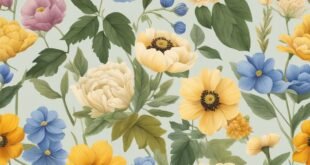Pressed Flower Magic: Capturing Botanical Delights in Art
The art of pressed flower arrangement has captivated individuals for centuries, offering a unique and enchanting way to preserve the beauty of nature. This article explores the fascinating world of pressed flower art, providing insights into the selection, preparation, design, and preservation of these delicate botanical treasures.
Choosing the right flowers for pressing is crucial in creating captivating pressed flower art. This process requires a keen eye for selecting flowers that possess vibrant colors, interesting shapes, and sturdy petals that can withstand the pressing technique. Additionally, understanding the seasonal availability and optimal harvesting times is essential for capturing the true essence of each flower.
Preparing and pressing techniques play a pivotal role in the success of pressed flower art. By employing gentle pressing methods, such as using heavy books or specialized flower presses, the fragile beauty of the flowers can be preserved. Attention to detail is paramount during this process to ensure the preservation of natural colors and the prevention of mold or discoloration.
Designing and arranging pressed flower art enables artists to create visually stunning compositions. By considering color harmony, texture variation, and spatial balance, artists can transform pressed flowers into captivating masterpieces. The use of various techniques, such as framing, collage, or three-dimensional arrangements, adds depth and dimension to the artwork.
Preserving and displaying pressed flower creations is crucial to maintaining their longevity and visual appeal. Proper storage techniques, such as using acid-free paper and protective enclosures, safeguard the delicate petals from environmental factors. Display options include shadow boxes, frames, or laminated designs that allow the intricate details of the flowers to be showcased.
In conclusion, pressed flower art offers a captivating way to capture the ephemeral beauty of botanical delights. Through careful selection, preparation, design, and preservation, artists can unlock the enchanting potential of these delicate treasures, creating artworks that transcend time and celebrate the wonders of nature.
Choosing the Right Flowers for Pressing
The selection of appropriate flowers for pressing is a crucial aspect to consider in order to achieve optimal results in botanical art.
It is important to choose flowers that are in good condition, with vibrant colors and intact petals. Flowers that are too old or damaged may not press well and can result in a less desirable outcome.
Additionally, it is important to consider the size and shape of the flower, as larger or more complex flowers may require special techniques or equipment to press effectively. Flowers with a flat or semi-flat shape, such as pansies or daisies, are often the most suitable for pressing.
Finally, it is essential to gather flowers responsibly, avoiding rare or protected species, and ensuring that the act of pressing flowers does not harm the natural environment.
Preparing and Pressing Techniques
One effective approach to preserve and enhance the beauty of plants involves employing specific techniques for preparation and pressing.
Preparation is a crucial step in ensuring that the pressed flowers retain their vibrant colors and delicate details. Before pressing, it is essential to choose flowers at their peak freshness and avoid those that are wilted or damaged. It is advisable to remove any excess moisture from the flowers by gently blotting them with absorbent paper. Additionally, removing any unwanted parts such as stems or leaves can help in achieving a more aesthetically pleasing result.
Pressing techniques vary, but a common method involves placing the flowers between layers of absorbent paper and applying even pressure using heavy books or a flower press. Patience is key, as the pressed flowers may take several weeks to fully dry and flatten.
Following these techniques ensures that the beauty of botanical delights is captured and preserved in art.
Designing and Arranging Your Pressed Flower Art
Designing and arranging pressed flower compositions requires careful consideration of color, texture, and spatial arrangement to create visually appealing and harmonious displays.
The choice of colors should be well thought out, taking into account the natural hues of the pressed flowers and ensuring a pleasing color scheme. Contrasting colors can create a vibrant and dynamic display, while complementary colors can evoke a sense of harmony.
Texture is another important element to consider, as it adds depth and visual interest to the composition. Combining flowers with different textures, such as delicate petals with rougher leaves, can create a tactile experience for the viewer.
Lastly, spatial arrangement plays a crucial role in the overall impact of the artwork. Balancing the placement of flowers and leaves, along with the use of negative space, helps to create a visually balanced and aesthetically pleasing composition.
By carefully considering color, texture, and spatial arrangement, one can create pressed flower art that captivates and delights the viewer.
Preserving and Displaying Your Pressed Flower Creations
Preservation and display techniques for pressed flower creations require careful consideration of environmental factors, such as humidity and light exposure, to ensure long-lasting and visually stunning results.
Proper preservation begins with choosing appropriate materials, such as acid-free paper and archival glue, to prevent deterioration and discoloration over time.
It is crucial to store pressed flower creations in a cool, dry place, away from direct sunlight, to avoid fading and damage. Additionally, humidity control is essential to prevent mold growth and maintain the delicate structure of the pressed flowers.
Display options include framing the artwork behind UV-protective glass or placing it in a shadow box to shield it from harmful light exposure.
By implementing these preservation and display techniques, pressed flower creations can be cherished for years to come, preserving their natural beauty and botanical delights.
Conclusion
In conclusion, pressed flower art offers a captivating way to capture and preserve the beauty of botanicals.
By carefully selecting and preparing flowers for pressing, utilizing proper techniques, and thoughtfully arranging the pressed flowers, one can create stunning pieces of artwork.
Additionally, preserving and displaying these creations allows for long-lasting enjoyment and admiration of the delicate beauty found in nature.
Pressed flower art is a testament to the enduring allure of botanical delights.
 Dzoor Botanical Crafts
Dzoor Botanical Crafts
